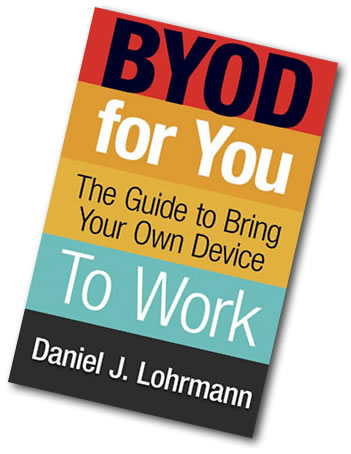 Almost every guidebook on BYOD looks at the subject from the point of view of management or the IT department. BYOD for You: The Guide to Bring Your Own Device to Work breaks apart from the pack by looking at BYOD from the point of view of the person bringing his or her own device to work. Written by Daniel Lohrmann, Michigan’s Chief Security Officer and Deputy Director for Cybersecurity and Infrastructure Protection, BYOD for You is a breezy, 54-page Kindle ebook that provides the perfect introduction to BYOD for end users at organizations that allow the work-related use of personal mobile devices.
Almost every guidebook on BYOD looks at the subject from the point of view of management or the IT department. BYOD for You: The Guide to Bring Your Own Device to Work breaks apart from the pack by looking at BYOD from the point of view of the person bringing his or her own device to work. Written by Daniel Lohrmann, Michigan’s Chief Security Officer and Deputy Director for Cybersecurity and Infrastructure Protection, BYOD for You is a breezy, 54-page Kindle ebook that provides the perfect introduction to BYOD for end users at organizations that allow the work-related use of personal mobile devices.
You’ll be able to read BYOD for You’s eight chapters, most of which are only a half-dozen pages long, within a couple of lunch breaks. It looks at all sorts of issues that come up in a workplace’s BYOD program, and not just the technological ones, but the social, legal, and ethical as well. Its chapters cover these topics:
- Categorizing your BYOD environment: Gold, Silver or Bronze?
- Your workplace’s BYOD program, or the lack thereof
- Security: How to safely use your mobile device at work and home
- MDM
- Privacy and other legal considerations
- Maximizing the financial benefits of BYOD
- Ethical dilemmas and proving you deserve your mobile device
- Building a personalized BYOD plan that outlives your device

Throughout BYOD for You, Lohrmann constantly refers to his “Gold, Silver, and Bronze” levels of BYOD use at businesses:
- Bronze: An organization operating at the Bronze BYOD level has employees who bring their own devices to work, but doesn’t have an official BYOD policy. Mobile policy is ad hoc rather than clearly defined. It’s unclear about what happens when company information security policies and personal devices collide, if employees’ personal data will remain private, or if their work-related activities on personal devices will get them in trouble. Employees also bear all costs of using the device, even for work-related purposes. MDM is practically or completely non-existent.
- Silver: In organizations operating at the Silver BYOD level, there is a basic BYOD policy that spells out how its data can be accessed, as well as issues of security and privacy, and there is tacit permission for employees to access their work email from their devices. Employees can choose between all-expenses-paid COPE devices or BYOD devices without any reimbursement for operating costs. MDM is limited; it’s often something basic, such as the management provided by Microsoft’s Exchange ActiveSync.
- Gold: At the Gold level of BYOD, there’s a full BYOD policy that specifies the rights, responsibilities of employees who bring personal mobile devices to work, and the procedures and practices they should follow. In a Gold organization, employees are fully reimbursed for all device costs. The company makes use of state-of-the art MDM that is mandatory on all mobile devices used for work purposes.
While BYOD for You was written for end users at a workplace, it’s just as useful a guide for managers or technical decision-makers who are new to the idea of BYOD and want to get a grasp of the major issues that can arise when employees bring their own devices to work. Packed with a lot of good ideas and best practices, It’s an easy read, and at $2.99 from Amazon (you can even borrow it for free if you’re on Amazon Prime), it’s also one of the better one of the better deals you’re going to find.
An Amazon review that gave BYOD for You a four-star rating suggested that “A companion book on what the COMPANY should be doing to manage their employee-owned devices would make a great follow-on to this practical, employee-centric work.” Perhaps we’ll write that book.
